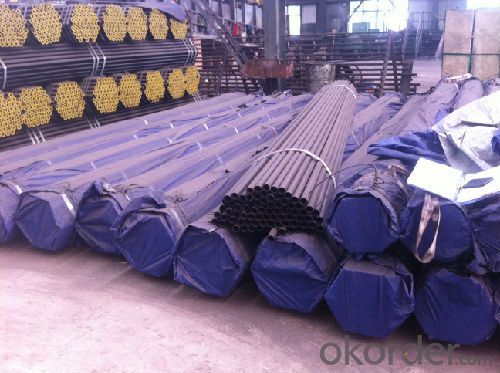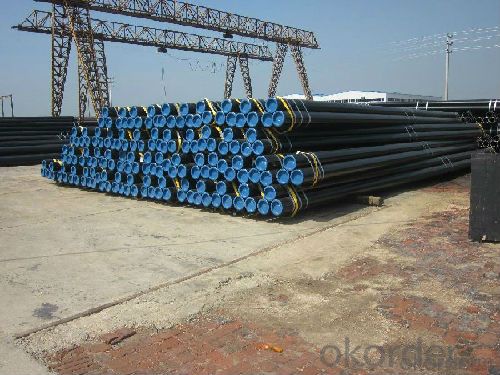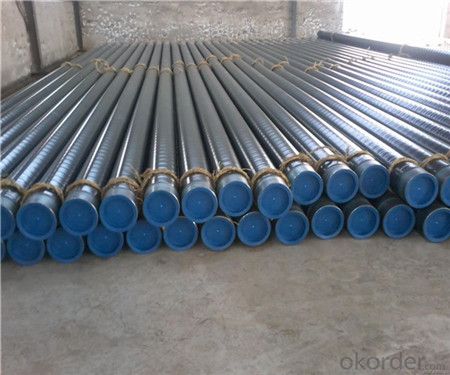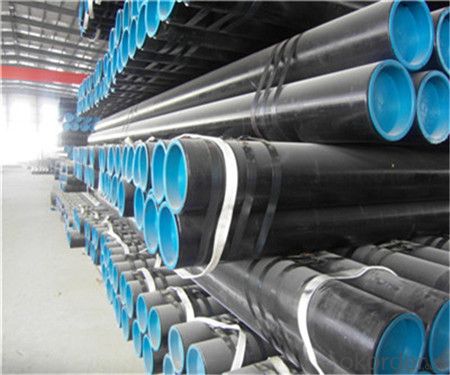Stainless Steel Pipe Seamless Steel Tube for oil Pipe
- Loading Port:
- China Main Port
- Payment Terms:
- TT or LC
- Min Order Qty:
- 30 m.t.
- Supply Capability:
- 12000 m.t./month
OKorder Service Pledge
OKorder Financial Service
You Might Also Like
1、Full series of products provides an easier access for one stop purchase
▲ Line pipe
▲ Tubing and casing
▲ L & M & H boiler tube
▲ Gas cylinder tube & pipe
▲ Mechanical & Structural pipe
▲ Ship-building tube & pipe
▲ Automobile tube & pipe
2、Main Features of the Seamless Pipe ASTM A106/53:
• High manufacturing accuracy
• High strength
• Small inertia resistance
• Strong heat dissipation ability
• Good visual effect
• Reasonable price
1.Seamless pipe professor
2.MTC,ISO,API certificate
3.ASTM,DIN,BS,JIS,GB
4.On time delivery
5.Big store,excellent package
3、Seamless Pipe ASTM A106/53 Specification:
Standard | GB, DIN, ASTM ASTM A106-2006, ASTM A53-2007 |
Grade | 10#-45#, 16Mn 10#, 20#, 45#, 16Mn |
Thickness | 8 - 33 mm |
Section Shape | Round |
Outer Diameter | 133 - 219 mm |
Place of Origin | Shandong, China (Mainland) |
Secondary Or Not | Non-secondary |
Application | Hydraulic Pipe |
Technique | Cold Drawn |
Certification | API |
Surface Treatment | factory state or painted black |
Special Pipe | API Pipe |
Alloy Or Not | Non-alloy |
Length | 5-12M |
Outer Diameter | 21.3-610mm |
Grade | 20#, 45#, Q345, API J55, API K55, API L80, API N80, API P110, A53B |
Standard | ASME, ASTM |
4、Packaging & Delivery
Packaging Details: | seaworthy package,bundles wrapped with strong steel strip |
Delivery Detail: | 15-30days after received 30%TT |
5、FAQ of Seamless Pipe ASTM A106/53:
①How is the quality of your products?
Our products are manufactured strictly according to national and internaional standard, and we take a test
on every pipe before delivered out. If you want see our quality certifications and all kinds of testing report, please just ask us for it.
Guaranteed: If products’ quality don’t accord to discription as we give or the promise before you place order, we promise 100% refund.
②How about price?
Yes, we are factory and be able to give you lowest price below market one, and we have a policy that “ for saving time and absolutely honest business attitude, we quote as lowest as possible for any customer, and discount can be given according to quantity”,if you like bargain and factory price is not low enough as you think, just don’t waste your time.Please trust the quotation we would give you, it is professional one.
③Why should you chose us?
● Full series of products provides an easier access for one stop purchase
▲ Electric Resistance Welded (ERW) Steel Pipe
▲ Longitudinal Submerged Arc Welded (LSAW) Steel Pipe
▲ Spiral Submerged Arc Welded (SSAW) Steel Pipe
▲ Hollow Section (Square and Rectangle Pipe)
▲ Hot Dipped Galvanized Steel Pipe
▲ Professional sales team
▲ Professional engineering and technology team
▲ Professional exportation and contract processing/management team
▲ Professional cooperators and partners




- Q:Advantages and disadvantages of stainless steel
- Mechanical properties: according to different types of stainless steel, the mechanical properties of different martensitic stainless steel with high strength, hardness, corrosion resistance and is suitable for manufacturing the need of high strength, high wear resistance parts, such as turbine shaft, stainless steel knives, stainless steel bearings, austenitic stainless steel and good plasticity, strength is not too but the high corrosion resistance of stainless steel is the best, very suitable for corrosion resistance and mechanical properties of less demanding situations, such as chemical plants, fertilizer plants, sulfuric acid, hydrochloric acid manufacturers of equipment materials, of course, can also be used for submarines and other military industries, ferrite medium mechanical properties of stainless steel body, but the intensity is not too high. Oxidation resistance, suitable for various industrial furnace parts.
- Q:Are stainless steel sheets resistant to galvanic corrosion?
- Indeed, galvanic corrosion can be prevented by using stainless steel sheets. When dissimilar metals encounter each other in the presence of an electrolyte like moisture or saltwater, galvanic corrosion ensues. The process involves one metal acting as an anode and the other as a cathode, resulting in the transfer of electrons and corrosion of the anode. Stainless steel, an alloy that incorporates chromium, possesses a passive oxide layer on its surface. This layer serves as a protective shield, impeding the transfer of electrons and effectively combatting galvanic corrosion. The chromium in stainless steel reacts with oxygen in the atmosphere, generating a thin, invisible, and self-rejuvenating layer of chromium oxide. This exceptional layer provides outstanding corrosion resistance, rendering stainless steel highly resistant to galvanic corrosion when combined with other metals. Nevertheless, it is worth noting that the level of corrosion resistance can vary depending on the specific grade and composition of stainless steel employed. Some stainless steel alloys, such as Type 316 stainless steel, offer even greater resistance to galvanic corrosion due to the inclusion of molybdenum, which bolsters its corrosion resistance in aggressive environments. In conclusion, stainless steel sheets typically exhibit remarkable resistance to galvanic corrosion due to the presence of a passive chromium oxide layer on their surface. This makes stainless steel an excellent choice for applications where galvanic corrosion poses a concern, such as marine environments or when in contact with dissimilar metals.
- Q:Can stainless steel sheets be used for medical implants or devices?
- Yes, stainless steel sheets can be used for medical implants or devices. Stainless steel is a commonly used material in the medical field due to its high strength, corrosion resistance, and biocompatibility. It is particularly suitable for applications such as surgical instruments, orthopedic implants, and dental tools, where durability and hygiene are essential.
- Q:Can stainless steel sheets be used for medical sterilization equipment?
- Yes, stainless steel sheets can indeed be used for medical sterilization equipment. Stainless steel is a popular material choice in the medical industry due to its excellent resistance to corrosion, high heat resistance, and durability. These features make stainless steel sheets ideal for various medical applications, including the construction of sterilization equipment. Stainless steel sheets can withstand high temperatures and repeated sterilization cycles without warping or degrading, making them suitable for autoclaves and other sterilization devices. Additionally, stainless steel is easy to clean and maintain, which is crucial for preventing the growth of bacteria or other harmful microorganisms. Thus, stainless steel sheets are commonly used in medical settings where sterilization equipment is required.
- Q:Why do galvanized and stainless steel sheets buy more expensive than thin ones?
- Effects: galvanized steel sheet is to prevent corrosion of steel plate surface and prolong its service life, and the surface of steel plate is coated with a layer of metal zinc. This kind of zinc coated steel plate is called galvanized sheet.
- Q:Can stainless steel sheets be used for jewelry?
- Yes, stainless steel sheets can be used for jewelry. Stainless steel is a popular material for making jewelry due to its durability, resistance to tarnish and corrosion, and affordability. It is commonly used in the production of rings, necklaces, bracelets, and earrings.
- Q:How do you remove water stains from stainless steel sheets?
- To remove water stains from stainless steel sheets, you can follow these steps: 1. Start by wiping the surface of the stainless steel sheet with a soft, damp cloth to remove any loose dirt or debris. 2. Mix a solution of warm water and mild dish soap in a bucket or bowl. Dip a clean cloth into the soapy water and wring out any excess liquid. 3. Gently rub the cloth over the water stains on the stainless steel sheet. Make sure to go along the grain of the stainless steel to prevent any further damage or scratching. 4. For tougher water stains, you can use a non-abrasive cleaner specifically designed for stainless steel. Apply a small amount of the cleaner to a clean cloth and gently rub it onto the stained areas. 5. Rinse the stainless steel sheet with clean water to remove any soap residue. Use a separate clean cloth or sponge to wipe away any excess water. 6. To prevent future water stains, you can apply a stainless steel cleaner or polish to the surface. Follow the instructions on the product label for the best results. Remember to always test any cleaning solution or product on a small, inconspicuous area of the stainless steel sheet before applying it to the entire surface. This will ensure that the cleaner or polish does not cause any damage or discoloration.
- Q:How do you drill holes in stainless steel sheets?
- To drill holes in stainless steel sheets, you will need to use a high-quality drill bit specifically designed for stainless steel. It is advisable to use a drill press or a stable drilling platform to ensure accuracy and prevent slippage. To reduce heat and friction, lubricate the drill bit with cutting fluid or a suitable lubricant. Begin by marking the desired hole locations on the sheet with a center punch, then start drilling at a slow speed, gradually increasing the speed as you progress. Be cautious not to apply excessive pressure to avoid damaging the sheet or causing the drill bit to break.
- Q:Are stainless steel sheets resistant to crevice corrosion?
- Stainless steel sheets generally possess resistance to crevice corrosion, which occurs in confined spaces like gaps or crevices between surfaces, where limited oxygen and other corrosive agents exist. These sheets are primarily composed of iron, chromium, and other alloying elements that generate a protective oxide layer on their surface, effectively preventing the infiltration of corrosive agents. This oxide layer acts as a barrier, endowing stainless steel with high resistance against crevice corrosion. However, it's worth noting that the degree of resistance can vary based on the specific grade and composition of the stainless steel, as well as the environmental conditions it encounters.
- Q:What are the benefits of using embossed stainless steel sheets?
- Embossed stainless steel sheets offer several benefits. Firstly, they provide a highly durable and long-lasting solution due to the strength and corrosion resistance of stainless steel. Additionally, the embossed pattern adds a unique aesthetic appeal, enhancing the overall look and feel of any space. Furthermore, the embossing helps to hide scratches and fingerprints, making the surface more forgiving and easier to maintain. Lastly, the texture created by embossing adds grip, making it suitable for applications where slip resistance is required, such as flooring or staircases.
1. Manufacturer Overview |
|
|---|---|
| Location | |
| Year Established | |
| Annual Output Value | |
| Main Markets | |
| Company Certifications | |
2. Manufacturer Certificates |
|
|---|---|
| a) Certification Name | |
| Range | |
| Reference | |
| Validity Period | |
3. Manufacturer Capability |
|
|---|---|
| a)Trade Capacity | |
| Nearest Port | |
| Export Percentage | |
| No.of Employees in Trade Department | |
| Language Spoken: | |
| b)Factory Information | |
| Factory Size: | |
| No. of Production Lines | |
| Contract Manufacturing | |
| Product Price Range | |
Send your message to us
Stainless Steel Pipe Seamless Steel Tube for oil Pipe
- Loading Port:
- China Main Port
- Payment Terms:
- TT or LC
- Min Order Qty:
- 30 m.t.
- Supply Capability:
- 12000 m.t./month
OKorder Service Pledge
OKorder Financial Service
Similar products
New products
Hot products
Hot Searches
Related keywords






























